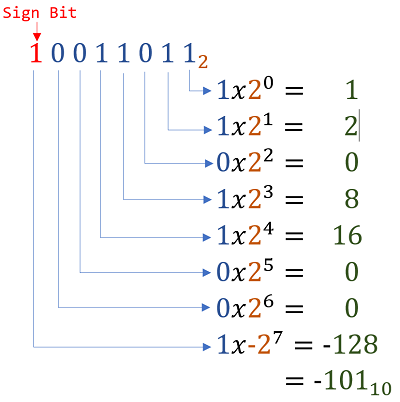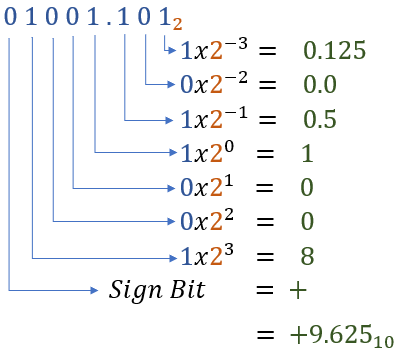Representing Numbers in Binary
Using bits to represent useful numeric type
Key Concepts |
|
Terms
| Term | Meaning |
|---|---|
| Binary | Base 2 numbers. |
| Decimal | Base 10 numbers. |
| Hex or Hexadecimal | Base 16 numbers. |
| Place or Place Value | Value of a single number in multi-symbol value. Example: In the number 12345, the Place Value if the 3 is 300. |
| Signed | Numbers that represent negative, zero, and positive values. |
| Symbols | Written characters used to depict numbers. Symbols represent to represent Decimal are 0,1,2,3,4,5,6,7,8,9. |
| Unsigned | Numbers that represent only zero and positive values. |
Introduction
The following table is a quick reference between binary and decimal numbers 0 - 15. For unsigned decimal numbers, 4 bits is all that in needed to represent 0 - 15
| Binary2 | Decimal10 | Binary2 | Decimal10 | |
|---|---|---|---|---|
| 0000 | 0 | 1000 | 8 | |
| 0001 | 1 | 1001 | 9 | |
| 0010 | 2 | 1010 | 10 | |
| 0011 | 3 | 1011 | 11 | |
| 0100 | 4 | 1100 | 12 | |
| 0101 | 5 | 1101 | 13 | |
| 0110 | 6 | 1110 | 14 | |
| 0111 | 7 | 1111 | 15 |
Unsigned Integers
Using the conversion algorithm we learned in Binary Values, you can verify the above table. Each binary value converts to the corresponding decimal l value.
Binary to Decimal Algorithm
Recall that array indexes start at zero(0). Number positions in a number string also start at zero. So the value in the 1st position is said to be in position 0
- Multiply a Binary value by 2 raised to the power if the value's position
- Add the result to the final Decimal result
- Repeat for all Binary values
The number of decimal values that can be represented in a fix number of binary digits (bits) is 2num of bits. The minimum value is 0 and the maximum is is 2num of bits.
4 bits can represent 24 or 16 values. 0 to 1510
16 bits can represent 216 or 65536 values. 0 to 6553510
Signed Integers
To be truly useful, we need to be able to represent negative (signed) values in binary. In order to accomplish this, we will sacrifice 1 bit to stand in for the +/- sign.
Before proceeding, we need to understand how to add 1 binary values. We will explore this moreIt is just like adding 2 decimal numbers:
A Full Adder
| A | B | Cin | Sum | Cout |
|---|---|---|---|---|
| 0 | 0 | 0 | 0 | 0 |
| 0 | 0 | 1 | 1 | 0 |
| 0 | 1 | 0 | 1 | 0 |
| 0 | 1 | 1 | 0 | 1 |
| 1 | 0 | 0 | 1 | 0 |
| 1 | 0 | 1 | 0 | 1 |
| 1 | 1 | 0 | 0 | 1 |
| 1 | 1 | 1 | 1 | 1 |
There are four (4) different possible combinations of bits added together:
- All three (3) input bits are zero (0) - Resulting in Sum 0 and Cout 0
- Only one (1) input bit is one (1) - Resulting in Sum 1 and Cout 0
- Two (2) input bits are one (1) - Resulting in Sum 0 and Cout 1
- All three (3) bits are one (1) - Resulting in Sum 1 and Cout 1
The Sign Bit
Computer designers chose the most significate bit to represent the sign of the remaining bits. 0 in the left most Sign Bit position indicates a positive value for the entire bit string. A Sign Bit of 1 indicates a negative value.

We can still represent 2num of bits values with a Sign Bit, however the maximum value represented is now 2num of bits - 1
4 bits can represent 24 or 16 values. -8 : +810
16 bits can represent 216 or 65535 values. -32786 : 3278610
| Binary2 | Decimal10 | Binary2 | Decimal10 | |
|---|---|---|---|---|
| 1111 | -7 | 0111 | +7 | |
| 1110 | -6 | 0110 | +6 | |
| 1101 | -5 | 0101 | +5 | |
| 1100 | -4 | 0100 | +4 | |
| 1011 | -3 | 0011 | +3 | |
| 1010 | -2 | 0010 | +2 | |
| 1001 | -1 | 0001 | +1 | |
| 1000 | -0 | 0000 | +0 |
We can see in this updates table that 1112 is still 710, however with the sign bit is 1 (1111), the value is -710. Check a couple of other values...for any two values where the three (3) least significate bits are the same, it is the same value, but positive is the sign bit is 0 and negative if it is 1.
Do you see any problems with this new table?
- Mainly there are two (2) bit strings that represent zero (0)
- And one if this is a negative zero (-1)
2's Complement
To fix these issues, signed binary values use a conversion algorithm called 2's Complement
Video on 1's and 2's complement representations of values
Table of 2's Complement Value in 4 bits
| Binary2 | Decimal10 | Binary2 | Decimal10 | |
|---|---|---|---|---|
| 0000 | 0 | |||
| 1111 | -1 | 0001 | +1 | |
| 1110 | -2 | 0010 | +2 | |
| 1101 | -3 | 0011 | +3 | |
| 1100 | -4 | 0100 | +4 | |
| 1011 | -5 | 0101 | +5 | |
| 1010 | -6 | 0110 | +6 | |
| 1001 | -7 | 0111 | +7 | |
| 1000 | -8 |
Converting 2's Complement Binary to Base 10
In a 2's complement system, the conversion is the same as unsigned, however the sign bit is negative
This example uses 8 bit values where the least 7 bits are the value/magnitude of the base 10 number being represented and the most significant bit is the sign bit


Convert a 2's Complement value to it's opposite value
In Base 10 we can multiply a value by -1 to switch from negative to positive -or- positiver to negative. In 2's complement binary were can perform the same conversion, using a 2-step process
Algorithm to convert between positive and negative values in 2's complement
- Flip all the bits
- Add 1 to the resulting bits
| Step | bit value | decimal value |
|---|---|---|
| Starting Value | 0101 | 5 |
| Flip the Bits | 1010 | n/a |
| Add 1 | 1011 | -5 |
note: the decimal value after flipping the bits does not matter
Use the above algorithm to test yourself
What is the 2's complement value for +2510 (0110012)
| Step | bit value | decimal value |
|---|---|---|
| Starting Value | 011001 | 25 |
| Flip the Bits | 100110 | n/a |
| Add 1 | 100111 | -25 |
Sign Extension
It is probably second nature that 2510 and 0000002510 are the same value. The most significant zeros do not change the value of the number. They are unnecessary.
-2510 and -0000002510 are also the same and unnecessary.
2's complement binary values have a similar property, but a little different that decimal values.
610 = 01102 = 000001102
We can lengthen a positive binary value by adding zeros (0) to the most significant bits without changing the value.
-610 = 10102 = 1111110102
We can lengthen a negative binary value by adding one (1) to the most significant bits without changing the value.
In effect, the additional ones or zeros are extending the sign bit. When removing the extra bits, the original sign bit must be retained so that the value keeps its original sign
In computer architecture, sign extension is not unnecessary. As we will see in logic circuits, sometimes binary value of 16 or 32, or 64 bits long is required, even if the original bit string was shorter. A hardware circuit can copy the sign bit as many time as needed to create the desired length bit string before executing certain instructions.
Fixed-Point
In order to represent fractional values in binary, a fixed number of the least significate bits can be designated as the fractional part. The remaining most significant bits are the whole number part

An architecture will define how many bits are used for the fractional and whole-number part. There is no bit used to hold the decimal point in memory. The hardware is configured to always, in the case of this example, use the 3 least significant bits.
The conversion from fixed point binary to base 10 fractional is the same as a whole number, however the fractions bits are multiplied by a fractional power of 2.
In base 10 we refer to the fractional digits as 10ths,100ths, 1000ths
In binary, maybe we call these fraction bits 1-2th,2-2ths, 3-2ths. Maybe not, since these parts do not have true names.
Regardless of the names, It falls to the assembly programmer to identify bits strings that represent fixed-point values. Then the architecture can apply the correct conversion to generate the correct decimal value.
Conclusion
Based on the architecture's design, integer and fractional values can be represented in binary. Because digital circuits do not have a decimal-place indication, the assembly program must use the architecture's rules on using fractional values.
Binary and digital circuits no have have a way to represent a negative value...only positive numbers. Using one of the value's bits to indicate the sign and the 2's Complement algorithm, binary values can be stored, used, and modified.
